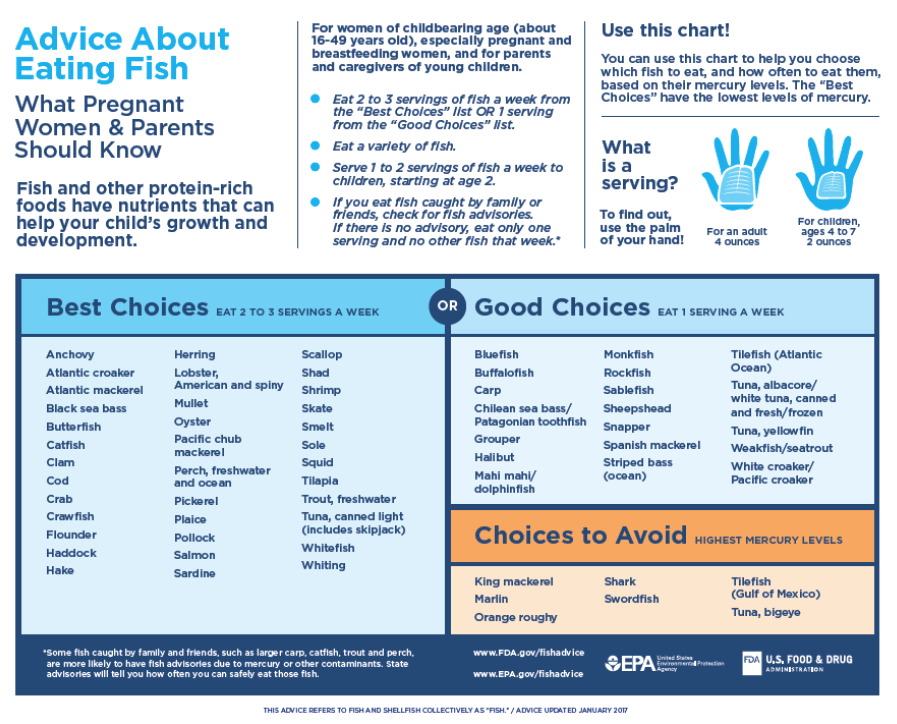What Do I Need to Know About Mercury in Fish?

You’ve likely seen articles that link high fish consumption with mercury poisoning, but the reality of the connection between the two is much more nuanced.
What kinds of fish contain mercury? How much fish can I eat without risk? What is really the cause for concern? Here’s the lowdown on what you need to know about mercury in fish.
How Mercury Enters the Food Chain
Mercury is a naturally occurring element that is present in fossil fuels, in plants and animals, and throughout our environment. It can be found in the rock in the earth’s crust, including in deposits of coal.
Mercury isn’t a problem until it is released from the rock and ends up in the atmosphere and in our lakes and oceans. This can happen naturally, through volcanic eruptions and forest fires. However, human activities are responsible for increased levels of released mercury into the air. Burning coal, oil, and wood as fuel can cause mercury to become airborne, and burning waste that contains mercury can result in airborne mercury as well.
From the air, mercury makes its way back to the ground via raindrops, dust, and gravity. In our streams, rivers, lakes, and oceans Mercury is consumed by bacteria and turned into methyl-mercury, which is easily absorbed by plankton and zooplankton. From there, the mercury works its way into our food chain starting with the small fish that eat the plankton. The highest concentrations of mercury are found in large, predatory fish that eat smaller fish, such as tuna.
How Mercury Affects Us
Mercury exists in three forms that have different properties, usage, and toxicity. The three types are elemental (or metallic) mercury, inorganic mercury compounds, and organic mercury compounds.
Organic mercury is the most dangerous form of mercury to human health. Methylmercury, the most predominant form of organic mercury, is the form that poses a risk through fish consumption. Methylmercury is better absorbed and shows a higher mobility in the human body than inorganic mercury.
Too much exposure to methylmercury can cause damage to the human brain and central nervous system. The symptoms may include trouble with motor coordination, sleep, speech, fatigue, weakness and loss of memory. Mercury exposure is especially a concern in the developing fetus and those exposed to high levels of mercury in the womb may suffer from problems with mental development, coordination, learning, and problem solving.
“Mercury exposure can also be detrimental to human health throughout the entire lifespan. Mercury can deposit in bone, cartilage, and other human tissues and contribute to inflammatory conditions like rheumatoid arthritis, osteoarthritis, and fibromyalgia. Mercury can also pass the blood-brain barrier and contribute to cognitive issues as well as dementia and Alzheimer’s later in life,” explains Functional Medicine dietitian Taylor Stolt.
How to Choose Fish Low in Mercury
Since all fish contain trace amounts of mercury and concentrations of the metal accumulate further up the food chain, it’s the more predatory fish that contain the higher levels of mercury.
The Environmental Protection Agency (EPA) and US Food & Drug Administration (FDA) produced a joint recommendation advising on the consumption of certain fish and shellfish species for pregnant women and children.
The EPA / FDA have concluded that the following people should eat more fish that is lower in mercury for important developmental and health benefits:
- Women of childbearing age (about 16-49 years old)
- Pregnant and breastfeeding women
- Young children
But these recommendations should be applied to everyone, Stolt explains. “Yes it is especially important for pregnant women, breastfeeding women, and young children to minimize their intake of fish that are high in mercury. But it’s important to understand everyone should be minimizing their consumption of high-mercury fish to decrease their risk of disease and promote optimal health.”
You’ll notice that not every fish species that you might encounter on a menu is listed in the recommendation, but that does not mean they are unsafe to eat. For example, because Barramundi is less common and there is not enough data collected on the species, it’s not yet included in the list.
What is the mercury content of Barramundi?
Wild-caught Barramundi and farm-raised Barramundi contain different mercury levels due to their different diets.
As mentioned before, methylmercury is primarily a concern in large predatory fish that consume other fish; therefore – large wild-caught Barramundi can have a higher concentration of mercury than farm-raised Barramundi.
At Australis, we pride ourselves in producing fish that we can all feel good about. For us, that means raising our Barramundi on a wholesome, custom-formulated diet consisting of plant-based protein, modest amounts of sustainably-sourced fish meal and fish oil, seaweed, yeast and herbs that naturally promote fish health.
The reduced use of wild fish in the diet ensures a low fish-in to fish-out ratio. This ratio is part of the reason our Barramundi meet Monterey Bay Aquarium’s requirements as a Best Choice rated product.
Because food safety and purity are of the utmost importance, we conduct regular independent testing to ensure the product is free of antibiotics, mercury, PCBs and other contaminants. We require our feed manufacturer to test the ingredients of each batch of feed that we give our fish to ensure that they are of the highest grade and purity. We also test the finished feed product each month to make sure it meets our quality standards.
Our fish stocks are independently audited and tested by the Institute for Marketecology to ensure that they meet the Whole Foods Standard for Mercury, which is no more than 0.22 PPM (parts per million) of mercury, a more rigorous standard than that of the Federal Drug Administration. The testing results show that our fish are consistently 90% below the Whole Food’s standard (below 0.02 PPM).
In short—you’ll never have to worry about mercury levels in The Better Fish® Barramundi!
“I love that I can confidently recommend The Better Fish® Barramundi to all of my clients and know that it will do nothing but benefit their health!” says Stolt. “There aren’t many food products out there that I can say that about.”
Sources:
